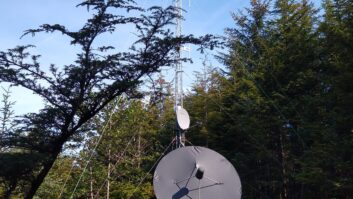
When Chuck Lakaytis, director of engineering for Alaska Public Broadcasting Inc., saw energy bills for his half-dozen 10 kW AM rural transmitter sites jump to around 50 cents per kWh, he knew something had to be done. “We questioned whether we could afford to continue the AM service.”
Lakaytis had an idea. He called his FCC attorneys as well as transmitter manufacturers Nautel and Harris. Soon, the commission had granted experimental authorization for APB’s KOTZ and KDLG to use energy-saving modulation schemes not legally available to U.S. broadcasters.
His presentation “Dynamic Carrier Control,” on Thursday morning at the NAB Broadcast Engineering Conference, describes his experiences with this green technology.
(click thumbnail)
These images are from a past presentation by Tim Hardy of Nautel about energy conservation in AM broadcast transmitters using carrier control algorithms. At KDLG in Dillingham, Alaska Public Broadcasting installed a Nautel XR-12 with amplitude modulation companding, or AMC. In Kotzebue, a Harris DX-10 was installed at KOTZ. It uses dynamic amplitude modulation, or DAM.
Both of these systems were developed in the early 1980s in response to rising energy costs in Europe. Amplitude Modulation Companding was developed by the BBC and is used both domestically and in all international shortwave transmitters. Dynamic Amplitude Modulation was developed by AEG Telefunken.
Although both systems are accepted and deployed widely elsewhere, their operation is not allowed in the United States because they violate FCC rules on carrier shift and maintenance of licensed power levels.
With DAM, the carrier is suppressed in relation to the modulation level. Both carrier and amplitude voltage are reduced in a linear fashion during low modulation, and increased at higher modulation levels.
AMC takes the opposite approach. The carrier is suppressed as modulation increases, and then rises to 100 percent of signal level during lower modulation periods. Even though signal-to-noise is compromised with lower carrier levels during modulation, the theory is that the increased modulation will mask the increased noise level, so there will be no perceived difference.
Lakaytis said a two-month trial of AMC at KDLG showed a 27 percent reduction in electricity costs. “We may be able to get it up to 30 percent by tweaking the audio processor.”
Several glitches and the severe Alaska winter delayed the installation of the DX-10 at KOTZ, so no data on energy savings were available at press time.
What surprised Lakaytis most was the high audio quality. “It was no different than the old system.” He adds that public radio listeners are a fussy group, yet there have been no complaints about audio quality or signal level. According to Lakaytis, it is also a bit disconcerting to see the transmitter’s power output meter jumping from 60 to 100 percent.
The experiment has not gone unnoticed by other Alaska broadcasters. Lakaytis has fielded inquiries from engineers at some of the local 50 kW commercial stations about the success of the new systems and how they can get in on the action.
“It all depends on how quickly the FCC can take action and make a change in the rules,” Lakaytis said.
(Ed. Note: The FCC has made it easier for noncom AMs in Alaska to use the technology. Read about it here.)
Offsets and certificates
Also participating at the Broadcast Engineering Conference on NAB Thursday will be Val Fishman, senior business development representative for Bonneville Environmental Foundation, who will participate in the session “Going Green and Seeing Black: Mainstreaming Green Technology Into Broadcasting.”
More businesses, including broadcasters, are seeking ways to reduce their carbon footprint. Fishman describes three ways by which stations can reduce their environmental impact: renewable energy certificates, or RECs; carbon offsets; and water restoration certificates, or WRCs.
RECs are used to offset the carbon emissions from the electricity a business uses. RECs represent renewable energy from sources such as wind, solar or biogas projects where clean energy has been directly delivered into the power grid to reduce carbon emissions from existing fossil-fueled power plants.
One REC represents the environmental benefits of 1-megawatt hour (MWh) of renewable electricity generated and delivered to the power grid. RECs are purchased from suppliers such as wind farms, solar plants and landfill gas facilities.
Questions are often asked about the effectiveness of renewable energy certificates. Do they really make a difference in reducing greenhouse gasses, or is it just good PR for the purchasers?
Fishman said Green-e, one of the leading certifiers, has a strict code of conduct and a thorough set of audit protocols.
“Any seller of Green-e certified products who violates Green-e protocols is notified by Green-e and their Green-e accreditation is revoked.” She adds that Green-e consumer protections are enforced by consumer fraud law.
Fishman says that companies use carbon offsets to offset the carbon emissions from activities such as air travel, employee commuting and product shipping.
“Carbon offsets represent the capture and reduction of harmful greenhouse gases emitted from sources such as animal waste, landfills or refrigerants.”


‘Green’ technology is the subject of several BEC sessions. Types of carbon offsets include renewable energy projects and bio-digesters that capture and flare methane gas from animal waste or landfills. A carbon offset represents the reduction of greenhouse gases equivalent to 1 metric ton of carbon dioxide (sold in units less than 1 metric ton and in units of pounds of CO2e, or carbon dioxide equivalent).
Water incentives
Fishman said a responsible water stewardship plan is a two-step process.
“First, conserve water in every way possible, including use of rainwater collection systems for non-drinking water uses, use of low-water plants and xeriscaping, and replacing single-pass cooling systems with closed-loop systems. Second, purchase WRCs as a way to take responsibility for the residual water footprint.”
Water restoration certificates are an outgrowth of water laws in the western United States. In many areas, they mandate that water rights holders use their allotted water or risk forfeiting their water rights forever. These laws result in many streams running dry, particularly in late summer.
“WRCs are a voluntary, market-based program that create economic incentives from water rights holders to leave water in critically dewatered systems,” Fishman said. Where there are new, progressive laws, water rights holders can restore water to rivers without forfeiting their valuable water rights. Each WRC represents 1,000 gallons of water that BEF will return to critically dewatered rivers and streams through supply contracts with local water trusts.
Fishman emphasizes that not all RECs and carbon offsets are created equal. Consumers shopping for green solutions should check to see that they are certified by a leading independent certification organization such as Green-e Energy, Green-e Climate and The Climate Action Reserve. More stringent suppliers may also require that all RECs and carbon offsets meet environmental impact and siting criteria set up by independent environmental organizations such as the Natural Resources Defense Council.












